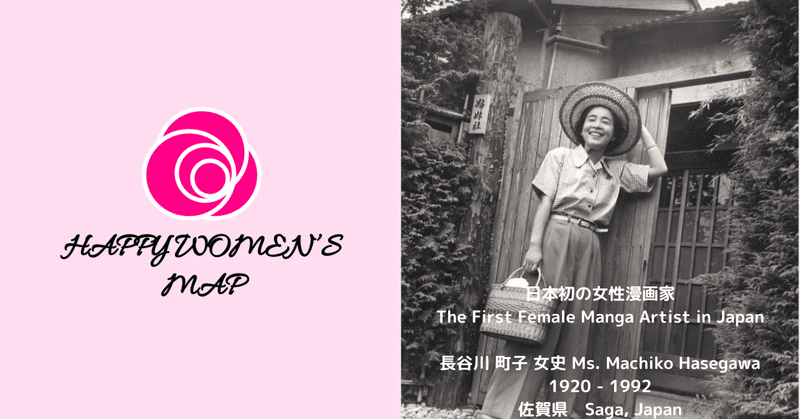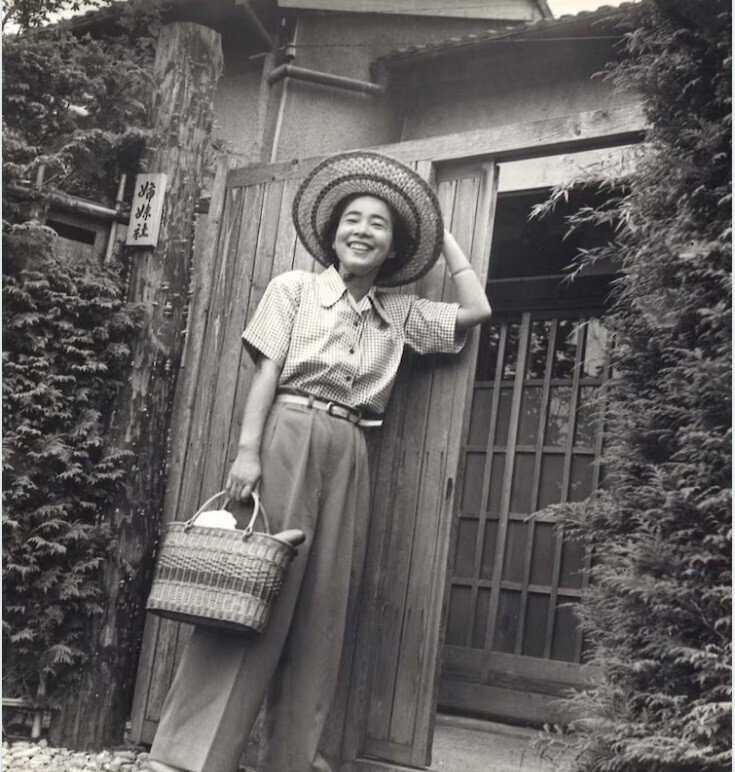
Happy Women's Map 佐賀県 日本初の女性漫画家 長谷川 町子 女史 / The First Female Manga Artist in Japan, Ms. Machiko Hasegawa

「毎日笑ってもらいたい」
"I want everyone to laugh every day."
長谷川 町子 女史
Ms. Machiko Hasegawa
1920 - 1992
佐賀県多久市 生誕
Born in Taku-city, Saga-ken
長谷川 町子 女史は日本初の女性漫画家です。日本で初めて漫画のキャラクターの著作権侵害裁判を起こして勝訴しました。代表作『サザエさん』『いじわるばあさん』『エプロンおばさん』。美空ひばり女史に続いて日本女性2人目の国民栄誉賞を受賞。
Ms. Machiko Hasegawa is the first recognized female manga artist in Japan. She initiated and won the first copyright infringement lawsuit involving manga characters in Japan. Her notable works include "Sazae-san," "Mean Grandma," and "Apron Aunt." Following Ms. Hibari Misora, She became the second Japanese woman to receive the People's Honor Award.
「天才少女」
町子は三菱炭坑の技師である父・勇吉と、政治家を兄に持つ母・貞子のもと3人姉妹として生まれます。やがて父・勇吉がワイヤーロープ事業を開業すると、家族で博多に転居してお手伝い2人を抱えて裕福な暮らしを始めます。町子は小さい頃から絵を描かせると上機嫌、学校の授業中の先生の似顔絵を描いてはクラスに回します。まもなく父・勇吉が病に倒れ逝去すると、母・貞子は家族でキリスト教に入信、国会議員の兄を頼って家族で上京します。次に母・貞子は、三姉妹の才能を伸ばそうと奔走します。姉の毬子は画家・藤島武二のもとで洋画を、妹の洋子は菊池寛のもとで文学を、町子は田河水泡のもとで漫画を学ばせます。15歳の町子は「天才少女」として『少女倶楽部』の『狸の面』で漫画家デビューします。1年に渡る住み込み見習いの後で自宅に戻って『ヒィフゥみよチャン』『仲よし手帖』を新聞・雑誌に連載します。
「サザエさん」
戦争が激しくなると、一家は福岡に疎開します。町子は西日本新聞社に入社、報道写真の修整・ルポルタージュの挿絵を描きます。仕事の合間には道端で馬糞を集めて家庭菜園に従事しながら敗戦を迎えると、西日本新聞社から独立した夕刊フクニチの連載漫画の仕事が舞い込みます。自宅の近くの百道海岸の砂浜と松林を妹と散歩をしながら『サザエさん』はじめ磯野家の日常を描き始めます。漫画が評判になるのを見越した母・貞子は家を売って一家揃って上京、「サザエさんを出版なさい」と3姉妹に命じます。家族4人で出版社「姉妹社」を設立して翌年の『サザエさん』第1巻から全68巻を刊行します。まもなく、朝日新聞社が創刊した夕刊朝日新聞に連載の場を移し、磯野家も東京を舞台として描くようになります。
「いじわるばあさん」
町子は家族・友人・担当記者の家庭をつぶさに観察しながら、アシスタントなしで1人で作品を書き続けます。「漫画は面白くなくては駄目なのよ」町子は毎日のアイディアを考え出すのに苦労して胃潰瘍になり手術を受けます。町子は『サザエさん』でたまったストレスを『いじわるばあさん』で発散するようにサンデー毎日で連載を開始。また、サザエ・カツオ・ワカメの三姉弟の似顔絵を観光バスの車体の両側面に無断で20年使用されたことに対し、日本で初めて漫画キャラクターの著作権侵害を提訴し5年後に勝訴しますが、自宅が放火されます。やがて財産争いで妹・洋子と絶縁。まもなく『サザエさん』を休載してそのまま再開せず、長谷川町子美術館がオープンすると「これからが私の青春よ!」と65歳の町子は大喜びします。
"Genius Girl"
Machiko Hasegawa was born into a family with three sisters, under her father Yukichi, a Mitsubishi coal mine engineer, and her mother Sadako, whose brother was a politician. When her father Yukichi started a wire rope business, the family moved to Hakata, where they began to live a prosperous life with two maids. Machiko, always in high spirits when drawing from a young age, used to draw portraits of her teachers during school, circulating them around the class. Soon after, Yukichi fell ill and passed away. Following his death, Sadako converted the family to Christianity and, relying on her brother, a member of the National Diet, moved the family to Tokyo. Sadako then worked tirelessly to develop the talents of her three daughters. The eldest, Mariko, studied Western art under painter Takeji Fujishima, the second, Yoko, studied literature under Kikuchi Kan, while Machiko was taught manga by Suiko Tagawa. At the age of 15, Machiko made her debut as a manga artist with "Tanuki no Men" in "Shojo Club" as a "genius girl." After a year of living as an apprentice, she returned home and began serializing "Hifu Miyo-chan" and "Nakayoshi Techou" in newspapers and magazines.
"Sazae-san"
As the war intensified, the Hasegawa family evacuated to Fukuoka. Machiko joined the Nishinippon Shimbun newspaper, where she worked on retouching news photographs and drawing illustrations for reportages. In between her work, she collected horse dung from the roadside for home gardening. With the war's end, she received a job offer for a serialized manga in the evening edition of the Fukuoka Nichinichi Shimbun after becoming independent from the Nishinippon Shimbun. While taking walks with her sister along the sandy beach and pine forest near their home at Momochi Seaside, Machiko began drawing the daily life of the Isono family, starting with "Sazae-san." Anticipating the success of the manga, her mother, Sadako, sold their house and instructed the three sisters to publish "Sazae-san." The family moved to Tokyo, established the publishing company "Shimai-sha" (Sisters Company), and published the first volume of "Sazae-san" in the following year, eventually completing all 68 volumes. Soon after, "Sazae-san" shifted to serialization in the evening edition of the newly founded Asahi Shimbun newspaper, and the Isono family's setting transitioned to Tokyo.
"Mean Grandma"
Observing her family, friends, and the households of assigned journalists meticulously, Machiko continued to write her works entirely on her own, without assistants. "Manga must be interesting," she emphasized. Machiko struggled with the daily challenge of coming up with ideas, leading to a stomach ulcer that required surgery. To release the stress accumulated from "Sazae-san," Machiko began serialization of "Mean Grandma" in Sunday Mainichi. Additionally, she filed the first lawsuit in Japan for copyright infringement of manga characters when unauthorized portraits of Sazae, Katsuo, and Wakame were used on both sides of a tourist bus for 20 years. She won the case after 5 years but faced the tragedy of her home being set on fire. Eventually, Machiko became estranged from her sister Yoko due to a dispute over inheritance. She later decided to suspend the serialization of "Sazae-san" without resuming it when the Hasegawa Machiko Art Museum opened. At the age of 65, she joyfully exclaimed, "This is the beginning of my youth!"

Share Your Love and Happy Women's Story!
あなたを元気にする女性の逸話をお寄せください!
Share your story of a woman that inspires you!
この記事が気に入ったらサポートをしてみませんか?
